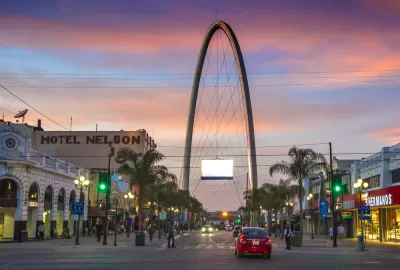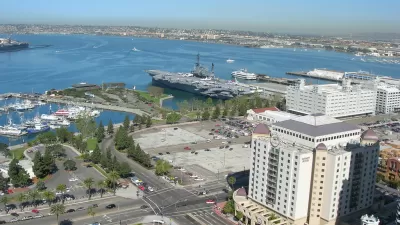On a recent tour of Tijuana for young land use professionals, San Diego architect Marin Gertler found a city that used the drought of U.S. tourism in the last decade to redefine and refine its urban core.

The combination of cartel violence and the U.S. recession were a one-two punch to the downtown Tijuana retail and restaurant economy. Long dependent on day tripper tourists and young American revelers, Tijuana was known primarily for its hawkers selling everything from tacky curios, to margaritas and beer, to more illicit goods and services—not to mention the tourists, many tacky themselves, who ambled or drunkenly stumbled down its streets.
The well publicized cartel violence, including some gun battles in Tijuana itself, deterred tourism. The recession, internet shopping, and long border waits all likely played a role too. Many Tijuana businesses, dependent on tourism, closed down, and the city's main tourist street, Avenida Revolucion, became a "ghost town of empty commercial spaces and former bars." However, this weaning from tourism (of the lowest variety) may have had a silver lining. On a recent tour put on by the Urban Land Institute San Diego/Tijuana Young Leader Partnership Forum, San Diego Gensler architect Marin Gertler found a revitalizing Tijuana urban core, not so dependent on tourism and catering more to young creatives—both local and from across the border. He writes about three stops on the tour that particularly inspired him. Find out more at the source article.
FULL STORY: Three great things happening now in downtown Tijuana, Baja California

Maui's Vacation Rental Debate Turns Ugly
Verbal attacks, misinformation campaigns and fistfights plague a high-stakes debate to convert thousands of vacation rentals into long-term housing.

Planetizen Federal Action Tracker
A weekly monitor of how Trump’s orders and actions are impacting planners and planning in America.

In Urban Planning, AI Prompting Could be the New Design Thinking
Creativity has long been key to great urban design. What if we see AI as our new creative partner?

King County Supportive Housing Program Offers Hope for Unhoused Residents
The county is taking a ‘Housing First’ approach that prioritizes getting people into housing, then offering wraparound supportive services.

Researchers Use AI to Get Clearer Picture of US Housing
Analysts are using artificial intelligence to supercharge their research by allowing them to comb through data faster. Though these AI tools can be error prone, they save time and housing researchers are optimistic about the future.

Making Shared Micromobility More Inclusive
Cities and shared mobility system operators can do more to include people with disabilities in planning and operations, per a new report.
Urban Design for Planners 1: Software Tools
This six-course series explores essential urban design concepts using open source software and equips planners with the tools they need to participate fully in the urban design process.
Planning for Universal Design
Learn the tools for implementing Universal Design in planning regulations.
planning NEXT
Appalachian Highlands Housing Partners
Mpact (founded as Rail~Volution)
City of Camden Redevelopment Agency
City of Astoria
City of Portland
City of Laramie



























